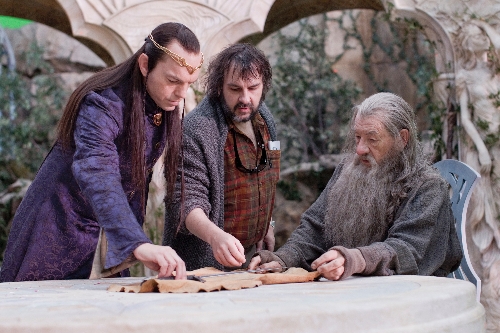‘Hobbit’ expands filmmaking world


Regardless of how it may sound, rest assured it doesn’t involve Bilbo running around the Shire, Benny Hill-style.
For his return to Middle-earth, director Peter Jackson broke with more than 80 years of tradition and shot “The Hobbit” trilogy at the rate of 48 frames per second, twice the standard for movies since “talkies” came around.
“Science tells us that the human eye stops seeing individual pictures at about 55 fps,” Jackson says in the press notes for “The Hobbit: An Unexpected Journey.” “Therefore, shooting at 48 fps gives you much more of an illusion of real life.”
It’s the “next big thing” for theaters in what’s been a year of next big things. Dolby Atmos. “The Dark Knight Rises” in IMAX. Now Jackson is changing the very look of movies with what’s been dubbed High Frame Rate 3-D.
At its best, it’s jaw-dropping and immersive as the format pulls you into the action like rarely before. At its worst – and these moments are few and far between – it’s closer to, “Hey, look, there’s Martin Freeman wearing hobbit ears on a wooden set.”
It’s still a work in progress, but the overall feeling is very much like the first time you saw high-definition TV.
“HFR 3-D is ‘different’ – it won’t feel like the movies you’re used to seeing,” Jackson notes, “in much the same way as the first CDs didn’t sound like vinyl records.”
Friday’s release of “The Hobbit” is a trial balloon for the format. James Cameron is considering shooting his “Avatar” sequels in 48 or even 60 frames per second. And, if everything goes well, other filmmakers are expected to follow suit.
As a result, Warner Bros. limited the number of theaters showing “The Hobbit” in HFR 3-D in order to maintain quality control, says Bruce Coleman, executive vice president of Brenden Theatres.
Brenden’s Palms location is one of three in the valley – along with Red Rock Resort and the South Point – showing the movie in the new format.
“We pride ourselves on being state of the art, so it was very important to us,” Coleman says. “We lobbied hard to make sure we got our Vegas location in particular as part of this.”
Ryan Schoen, Brenden’s director of engineering, says he spent “maybe a day’s work per auditorium” upgrading the projectors in two theaters as well as updating software and the server for the demands of HFR 3-D. After all, more frames means more data to store, and Schoen says “The Hobbit” is in the 400 gigabyte range.
The projectors had to be recalibrated and the 3-D tweaked before the colors were adjusted to make sure they look the same in each eye. “Otherwise it will give you a headache, if one eye is darker or lighter, or if one’s brighter than the other,” Schoen explains. “There’s quite a bit of set-up to do.”
Richard Grover, director of marketing and communications for Regal Entertainment Group, says Red Rock was chosen because it’s “one of our stronger performing locations in Las Vegas.” Multiple theaters were upgraded there, too.
(Representatives of Cinemark, which operates the South Point theaters, chose not to comment.)
Perhaps the best news for moviegoers is that, despite the expense involved in the upgrades, the theaters aren’t passing along those costs, beyond the standard 3-D and IMAX surcharges.
So while you could always see the film in two dimensions, if you’re feeling adventurous, there are nearly as many ways to see “The Hobbit” as there are dwarves in “The Hobbit.”
Among the additional formats – which, after a while, start sounding like bad Scrabble hands – are 3-D, IMAX 3-D, HFR 3-D, IMAX HFR 3-D, XD HFR 3-D and HFR 3-D with a Dolby Atmos kicker.
“Just anything to improve the visual experience, we’re excited about,” Brenden’s Coleman says. “I think that’s all exciting technology and just more pleasurable for the viewer.”
And, at least in the early stages, “Hobbit” fans seem to be excited, too.
“We’ve been pleased by the number of tickets that have sold for the High Frame Rate 3-D presentation,” Regal’s Grover says. “That there is a large group that’s eager to see what Peter Jackson has worked so hard to deliver to screen.
“We’re excited to see, too, what Peter Jackson has created with this new format.”
Contact Christopher Lawrence at clawrence@review journal.com or 702-380-4567.












